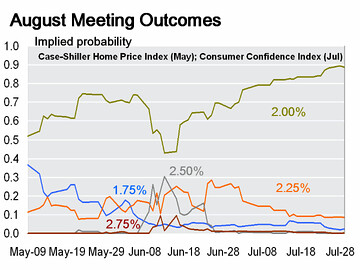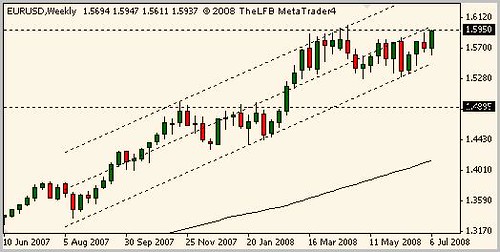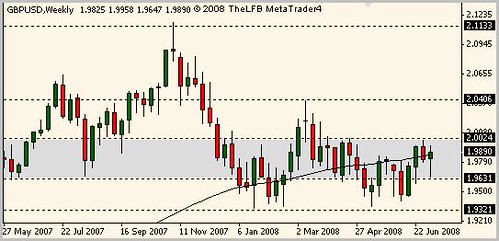Written by A Forex View From Afar on Thursday, July 10, 2008
Back to www.thelfb-forex.com
For the second part of the year, I see foremost a slowdown for the major economies. The GDP numbers will be much lower than seen in Q1, for most economies, including Europe, Japan and UK. I do see a slightly bigger quarterly read for the US economy, and that may be bullish for the dollar.
In my view the feeble economies will be reflected in the currency pair valuations, which will mostly trade in wide ranges. There will be a race between which between the Euro-Zone and the US as to which shows the first signs of recovery, thus for the euro, I see a prologue period ranging between the 1.53 and 1.58 levels, maybe finally managing to break somewhere lower. For the year end, 1.50 will be my target. The main reason being that we have not yet begun the real pull-back in the European Union releases, but have heard that most member states are struggling for growth in H2 2008.
The Housing sector will find a bottom somewhere between the end of the third quarter and the start of the first in 2009, which will be seen in the GDP read. I do not expect the US GDP, in Q4 to be over 0.5% (or 2% annualized), while the European GDP can be expected somewhere around the 0.7% area.
The Pound will be dragged lower by an economy that is moving at a stalling speed. The UK housing market will not find a bottom anywhere near year-end 2008, and will continue to drag the real economy lower. Just what the U.S. is coming out of in 2009 the U.K. will be going into the heart of. The $2 parity will be a forgotten dream in just a few months, but I do expect the pair to slowly move lower, rather than tanking, and do see it having some fights on its way down as fair value is found day-to-day. I do expect the pair to reach the 1.9200 area, but not to hold down there for too long. For the year-end, the 1.9300-1.9500 area could be a good target.
What I do expect to see is to see the yen-equities correlation further separate in the coming months. Thus, I see the S&P falling, and in the worst case to somewhere around the 1150. I do see it soon recovering from that drop and slowly move up. My read for the year end is somewhere in the 1400-1500 area. For the UsdYen, I can’t see it going lower than the 103.00. Once it reaches that area (and maybe 105.00 will hold it up and stop the rot), it will slowly move up toward the 108.00 area and stay there for a long period. At the beginning of 2009, the Yen will trade somewhere in the 112.00 area.
I do expect the swissy to move up for the rest of this year, battling the treasury note market, and tracking the yields that the Fed really need to keep inflated to attract overseas investment that funds the Current account imbalance. My target is somewhere around the 1.110 area for the year end.
For the aussie I expect to move lower, but to have a big fight on it’s way down. A slowing economy coupled with falling commodities, (in my view metals will drop in H2 2008), will be a drag on this pair, despite the huge swap interest that it pays. The 0.9000 area looks like a nice target for the year end.
As I said, I do expect commodities to move lower, they seem to be in a bubble, although I can’t see them poping, as usually happens in a bubbly enviroment. I expect commodities to move lower slowly over time, especially for oil that I see stairstepping lower as the global economy pulls back a little. My target is $90 per barrel for oil, which considering the oil prices just a few years ago I still see it very expensive

| Posted in »
forex


 | Posted in »
| Posted in »



